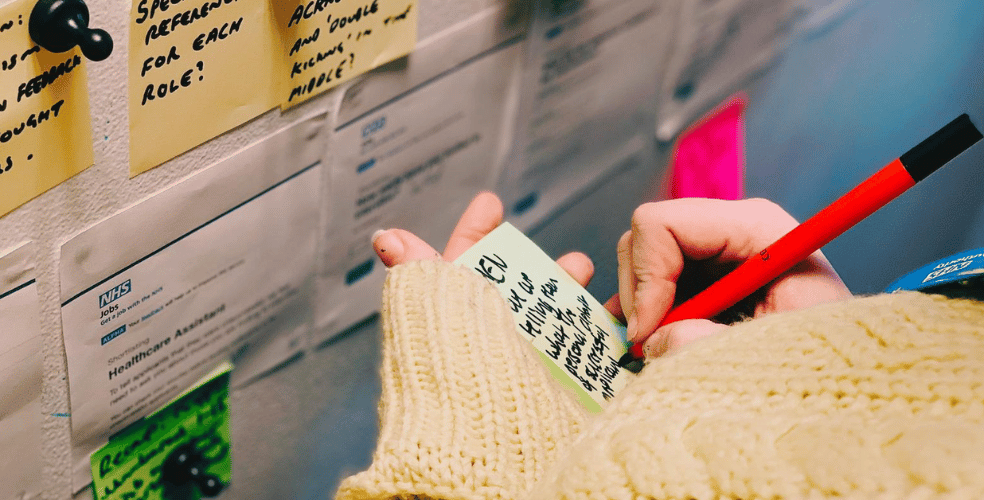In a recent discovery project, the small team I was working with had a challenging 7-week timeframe to complete research, service design and a technology deep-dive.
Our task was to look at a digital solution for the management and delivery of sexual health services. Provision of services in this area had historically meant local health boards and trusts buying their own off-the-shelf systems, implementing them and not investing any further. However, there was a commitment to wanting to take a different approach this time, genuinely understanding and making decisions about how best to meet user needs across a whole health system at a national scale.
Focussing on service outcomes
In similar work, we’ve commonly found situations where IT systems – or, the lack of IT systems – are defining how services are delivered in areas like sexual health. That was exactly what had been happening here. The system had been shaping everything from processes to outcomes.

In a common scenario, organisations buy a new IT system and try to make it fit their needs. But when an IT system defines a service, then the constraints, limitations and idiosyncrasies of underpinning software solutions drive the way a service is delivered. This then impacts business processes, ways of working, and user experience.
In this scenario, organisations end up making compromises to make services fit their software choices. For example, where users have to be asked to do odd things like re-enter data, or complete unnecessary tasks and journeys that don't match with their expectations and needs.
Alternatively, IT systems should be defined from an understanding of clearly articulated and intentional service outcomes and user needs. Not the other way around.
To work in this alternative way, we started by building on existing work completed by in-house teams to agree the highest priority service outcomes. As work progressed, we were then able to plan as a team to focus future design recommendations on the highest value opportunities for the system to deliver these outcomes. Exploring users' needs that best supported them became the priority, while remaining open to opportunities to meet user needs in other areas of the system as they emerged.
Using service design to understand part of a larger system
We decided right at the start – before we did any user research – to capture existing knowledge about the system and how it works.
Through initial workshops, we captured, plotted and affinity sorted data into a set of pain points – specific problems or difficulties that impact user experience or service outcomes. We presented this back as clear, easy to understand insights – what we described as a pain point map. This became a living artefact that we added to as new knowledge and insights emerged throughout the rest of discovery. While initial work was very much like a black and white outline, user research gradually added color to this – building on our existing knowledge to further develop the pain point map as we heard about experiences directly from people.
We prioritised matching where pain points sat against achieving our agreed service outcomes, giving us a clear high-level view of the current state of sexual health management and delivery across a whole population.
Utilising service patterns
Alongside the team’s work on the pain point map, I led work to build an understanding of common service stages. With such a short project timeline, there wasn’t time to map a detailed ‘as is’ view of every single journey within sexual health. This was the impetus for the team taking a patterns-based approach. This meant identifying and visualising the common service stages that were true across different pathways – with research then helping to build a clearer picture of the existing situations in each of those stages across health boards.
We initially evaluated health boards’ websites, looking at the different pathways that made up each sexual health service. These pathways ranged from reproductive health, through to chronic STD treatment. We then mapped high-level journeys based on what was available online – starting to identify where there were service stages that cut across all different journeys and service pathways. For example, something like giving a sample – this could be giving a sample for a pregnancy test, or it could be giving a sample for an STI test, or it could be giving a sample for cervical screening. The team then worked through these common service stages step by step asking: how might technology best support this?
We knew that there would be outliers in this approach, with our team confirming that some parts of the system do have more specific requirements. For example, with cases of sexual assault, where people move into the criminal justice system and there are different requirements and constraints to consider. But we identified that these would be additional to main cross-cutting service stages the team identified i.e. building on a base-level service, rather than needing a totally different set of solutions.
Using this patterns-based approach, we were able to visualise different and complex pathways in a way that was understandable and can now be easily communicated. For example, showing a journey that applies equally to getting an IUD (intrauterine device) fitted, or for getting a pregnancy test – with work documenting how the system would support each stage of these common journeys.
Underpinning user-focused technology decisions
The service design approaches that underpinned this work kept the team focussed on where we could add the most value within a limited timeframe. They allowed us to maximise our impact by ensuring that every element of the work, whether research, design or tech, was driven by the same high-priority service outcomes and user needs.
Final technical recommendations were focused on conveying a modern software development approach, but achieved with this service focus. This supported close collaboration with our tech consultant throughout. It meant our team could work together to understand what was technically viable, as well as the best potential uses of technology to meet the future needs of the system, shaping final discovery recommendations.

